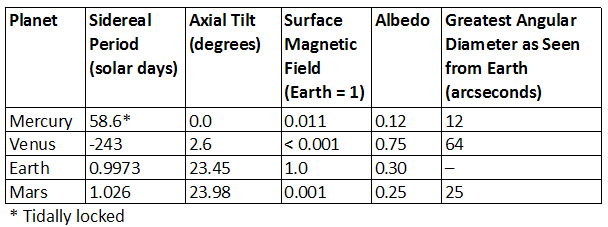Lesson 7 - The Terrestrial Planets
Reading Assignment
-
•Chapter 8.2: Physical Properties (Mercury)
-
•Chapter 8.1: Orbital Properties (Mercury)
-
•Chapter 8.4: Rotation Rates (Mercury)
-
•Chapter 8.7: Interiors (Mercury)
-
•Chapter 8.3: Surface Features on the Moon and Mercury (Mercury)
-
•Chapter 8.6: The Surface of Mercury
-
•Chapter 8.9: Evolutionary History of the Moon and Mercury (Mercury)
-
•Chapter 9.1: Orbital Properties
-
•Chapter 9.2: Physical Properties
-
•Chapter 9.6: Venus's Magnetic Field and Internal Structure
-
•Chapter 9.3: Long-Distance Observations of Venus
-
•Chapter 9.4: The Surface of Venus
-
•Chapter 9.5: The Atmosphere of Venus
-
•Chapter 10.2: Physical Properties
-
•Chapter 10.1: Orbital Properties
-
•Chapter 10.7: Martian Internal Structure
-
•Chapter 10.3: Long-Distance Observations of Mars
-
•Chapter 10.4: The Martian Surface
-
•Chapter 10.5: Water on Mars
-
•Discovery 10-1: Life on Mars?
-
-
•Chapter 10.6: The Martian Atmosphere
-
•Chapter 10.8: The Moons of Mars
Summary of Terrestrial Planet Physical Data
Summary of Major Moon Physical Data
Math Notes
Maximum Height of Shield Volcanoes
Read Chapter 10.4.
-
•The height that a shield volcano can attain depends on how much weight it can support, which depends on how strong a planet's surface gravity is. On Earth and Venus where the surface gravities are similar, shield volcanoes can grow to about 10 km. On Mars where the surface gravity is about 2/5 of Earth's and Venus's, shield volcanoes can support 5/2 = 2.5 times as much material, and consequently can grow 2.5 times as tall. Indeed, the tallest shield volcano on Mars, Olympus Mons, is 25 km = 2.5 × 10 km.
There are no additional math notes for Lesson 7: This material is more qualitative. However, in Homework 7, you will apply Lesson 6's math notes as you compare the other terrestrial planets to Earth and the moon.




